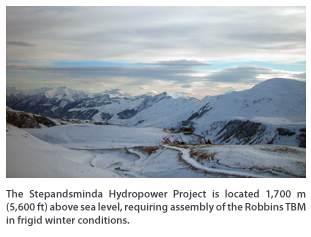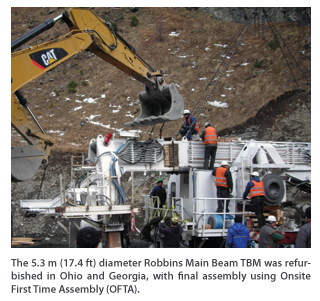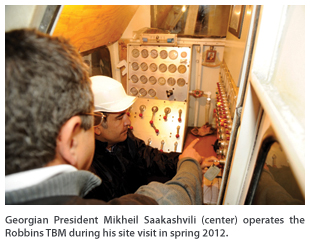Presidential TBM Visit for Robbins
June 14, 2012
 In April 2012, a crowd of media, dignitaries and workers greeted the President of Georgia, Mikheil Saakashvili, as he visited a Robbins TBM high in the mountains of Kazbegi. President Saakashvili toured the site of the Stepantsminda Hydropower Project, even operating the machine from the cab.
In April 2012, a crowd of media, dignitaries and workers greeted the President of Georgia, Mikheil Saakashvili, as he visited a Robbins TBM high in the mountains of Kazbegi. President Saakashvili toured the site of the Stepantsminda Hydropower Project, even operating the machine from the cab.  Components of the 5.3-m (17.4 ft) diameter Main Beam TBM were partially refurbished in Robbins’ Solon, Ohio, facility, as well as at contractor Peri LLC’s shop in Georgia. Final assembly took place at the jobsite using Onsite First Time Assembly (OFTA). The TBM was launched in February 2012 from a remote, snowy jobsite located 1,700 m (5,600 ft) above sea level. TBM components were trucked 160 km (100 mi) from the capital Tbilisi up one-lane, sometimes unpaved mountain roads. Once at the site, Peri and Robbins personnel assembled the TBM in about 40 days, enduring temperatures that dipped to negative 40 degrees Celsius with the wind chill factor. “The assembly team could only work an hour and a half to two hours at a time at the site, and then we had to go back into the shelter to warm up,” said Gene Lockhart, Robbins special projects manager, who headed up the project team.
Components of the 5.3-m (17.4 ft) diameter Main Beam TBM were partially refurbished in Robbins’ Solon, Ohio, facility, as well as at contractor Peri LLC’s shop in Georgia. Final assembly took place at the jobsite using Onsite First Time Assembly (OFTA). The TBM was launched in February 2012 from a remote, snowy jobsite located 1,700 m (5,600 ft) above sea level. TBM components were trucked 160 km (100 mi) from the capital Tbilisi up one-lane, sometimes unpaved mountain roads. Once at the site, Peri and Robbins personnel assembled the TBM in about 40 days, enduring temperatures that dipped to negative 40 degrees Celsius with the wind chill factor. “The assembly team could only work an hour and a half to two hours at a time at the site, and then we had to go back into the shelter to warm up,” said Gene Lockhart, Robbins special projects manager, who headed up the project team.  A complete contract supply by Robbins including continuous conveyors, cutters, spare parts, field service, and project management is being provided at the site. “We jointly worked with the Robbins field service team from the very beginning. We appreciate their experience and relied on them during the working process, where they trained our staff on operation, refurbishment and assembly,” said Nana Gvazava of Peri LLC.
A complete contract supply by Robbins including continuous conveyors, cutters, spare parts, field service, and project management is being provided at the site. “We jointly worked with the Robbins field service team from the very beginning. We appreciate their experience and relied on them during the working process, where they trained our staff on operation, refurbishment and assembly,” said Nana Gvazava of Peri LLC. As of May 2012, the TBM had advanced more than 500 m (1,700 ft) into its 5.5-km (3.4-mile) headrace tunnel through slate, sandstone and malm, with the continuous conveyors operating at high availability.
The Stepantsminda Hydropower Project, with support from the government-owned Georgian Energy Development Fund, Peri LLC, and Robbins, is part of
 a massive scheme to develop the country’s largely untapped hydropower reserves. The mountainous country has the potential to provide enough power for nearly 3 million homes per year, but only 25 percent of these areas have been developed. Once operational in 2016, the Stepantsminda plant will draw water from the Tergi River near the Georgian-Russian border, creating an annual 68 MW capacity. Electricity from the plant will be sold within Georgia, as well as neighboring countries including Turkey.
a massive scheme to develop the country’s largely untapped hydropower reserves. The mountainous country has the potential to provide enough power for nearly 3 million homes per year, but only 25 percent of these areas have been developed. Once operational in 2016, the Stepantsminda plant will draw water from the Tergi River near the Georgian-Russian border, creating an annual 68 MW capacity. Electricity from the plant will be sold within Georgia, as well as neighboring countries including Turkey. This article was supplied by The Robbins Co., headquartered in Solon, Ohio.
